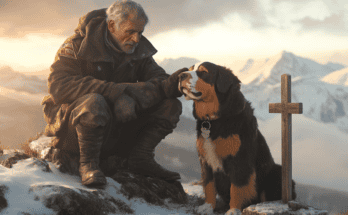Mountain dogs, such as the Bernese Mountain Dog, Great Pyrenees, and Saint Bernard, are large, strong, and loyal companions originally bred for working in harsh terrains. Owning a mountain dog requires proper care, training, and attention to their unique needs. This guide covers essential mountain dog care tips for new owners, including diet, grooming, exercise, training, and health management.

1. Understanding Mountain Dogs
Before bringing home a mountain dog, it’s important to understand their characteristics:
- Large size & strength – Require space and careful handling.
- Thick double coat – Needs regular grooming to prevent matting.
- Protective nature – Originally bred as livestock guardians.
- High energy levels – Need daily exercise and mental stimulation.
- Cold-weather adaptability – Thrive in cooler climates but can overheat in warm weather.
2. Diet & Nutrition for Mountain Dogs
A well-balanced diet is crucial for a mountain dog’s growth, energy, and overall health.
Best Diet for Mountain Dogs
- High-quality protein (chicken, beef, fish, lamb) supports muscle development.
- Healthy fats (Omega-3 & Omega-6) promote coat health and joint support.
- Complex carbohydrates (sweet potatoes, brown rice, quinoa) provide sustained energy.
- Vitamins & minerals (calcium, glucosamine) strengthen bones and joints.
Feeding Schedule
| Age | Meals Per Day |
|---|---|
| 8-12 weeks | 4 meals |
| 3-6 months | 3 meals |
| 6-12 months | 2-3 meals |
| 12+ months | 2 meals |
Foods to Avoid
- Chocolate
- Grapes & raisins
- Onions & garlic
- Excessive dairy
- Processed or salty foods
3. Grooming & Coat Care
Mountain dogs have thick coats that require regular maintenance to stay healthy and mat-free.
Grooming Routine
- Brushing: Brush at least 3-4 times a week to remove loose fur and prevent tangles.
- Bathing: Bathe once every 6-8 weeks using a gentle dog shampoo.
- Ear Cleaning: Check and clean ears weekly to prevent infections.
- Nail Trimming: Trim nails monthly to avoid overgrowth and discomfort.
- Dental Care: Brush teeth 2-3 times per week to prevent plaque buildup.
4. Exercise & Activity Needs
Mountain dogs need daily physical activity to stay fit and prevent behavioral issues.
Recommended Activities
- Daily Walks: At least 45-60 minutes of moderate-paced walking.
- Hiking & Outdoor Adventures: Ideal for their stamina and love for nature.
- Playtime & Fetch: Stimulates their natural working instincts.
- Obedience Training Games: Keeps their minds active.
Preventing Overheating
- Exercise during cooler hours in warm climates.
- Provide shade & fresh water during activities.
- Avoid excessive exercise in hot weather.
5. Training & Socialization
Early training and socialization ensure your mountain dog grows into a well-behaved companion.
Basic Obedience Training
- Sit – Encourages calmness.
- Stay – Teaches patience.
- Come – Ensures recall for safety.
- Leave It – Prevents eating harmful objects.
- Heel – Helps with leash manners.
Socialization Tips
- Expose your puppy to different environments, people, and sounds early.
- Arrange playdates with friendly dogs.
- Introduce them to household sounds like vacuum cleaners and doorbells.
- Reward calm and confident behavior.
6. Health & Common Medical Concerns
Mountain dogs are prone to specific health issues due to their size and genetics.
Common Health Problems
| Condition | Symptoms | Prevention/Treatment |
| Hip Dysplasia | Limping, difficulty standing | Maintain healthy weight, joint supplements |
| Bloat (GDV) | Restlessness, swollen abdomen | Feed in smaller portions, avoid vigorous exercise after meals |
| Arthritis | Stiffness, reluctance to move | Provide orthopedic bedding, regular vet check-ups |
| Ear Infections | Scratching, odor, head shaking | Clean ears weekly |
| Heart Issues | Lethargy, coughing | Regular vet screenings |
Vet Check-Ups & Vaccinations
- Regular Check-Ups: Schedule annual vet visits.
- Vaccination Schedule:
- 6-8 weeks: DHPP (Distemper, Hepatitis, Parvovirus, Parainfluenza)
- 10-12 weeks: Second DHPP, Bordetella
- 14-16 weeks: Rabies, Third DHPP
- Annual: Rabies booster, Leptospirosis, Lyme (if needed)
7. Creating a Comfortable Living Space
Mountain dogs need a spacious and safe environment to thrive.
Indoor Needs
- Provide a large, orthopedic dog bed for joint support.
- Keep water accessible at all times.
- Use baby gates if needed to set boundaries.
Outdoor Space Requirements
- Secure fenced yard to prevent wandering.
- Provide a cool, shaded area in hot climates.
- Avoid leaving them outside for extended periods in extreme weather.
8. Traveling with a Mountain Dog
Taking your mountain dog on trips? Here’s how to make travel comfortable.
Travel Tips
- Use a large, secure crate for car rides.
- Bring water, food, and a travel bowl.
- Stop for bathroom and exercise breaks.
- Check if your destination is pet-friendly.
- Never leave them alone in a hot car.
Final Thoughts
Owning a mountain dog is a rewarding experience, but it comes with responsibility. By following this guide, you’ll ensure your furry friend stays healthy, well-behaved, and happy. With proper diet, grooming, exercise, training, and health care, your mountain dog will be a loyal companion for years to come! 🐶❤️


